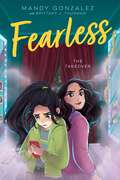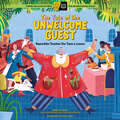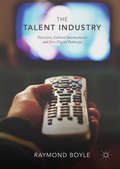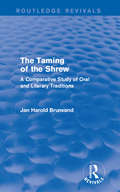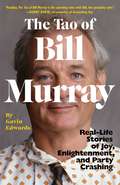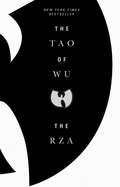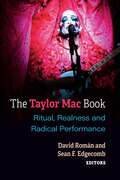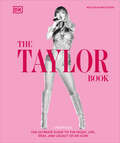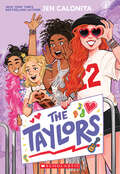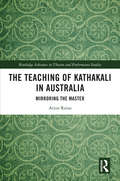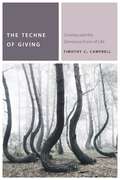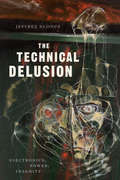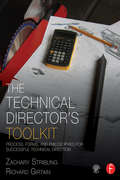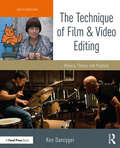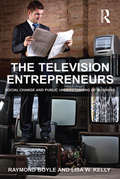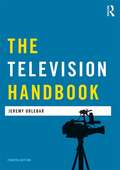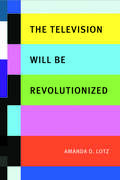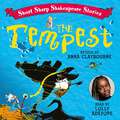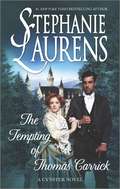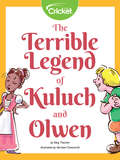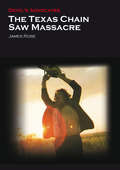- Table View
- List View
The Takeover (Fearless Series #4)
by Mandy GonzalezBetter Nate than Ever meets Love Sugar Magic in this fourth and final novel in the Fearless middle grade series from Hamilton and Broadway star Mandy Gonzalez about a young thespian and emerging influencer whose social media gets hacked.Twelve-year-old April DaSilva loves performing—and connecting with fans on her social media accounts. Thanks to her role in the hit Broadway show Our Time, she is close to reaching a huge follower milestone. In celebration, she&’s hosting a contest: three lucky followers will win a special backstage tour and tickets to the show. April feels on top of the world, but her brother isn&’t so thrilled about her attention always being glued to a screen. His warnings don&’t bother April. What&’s wrong with wanting more followers and likes? When meet and greet day arrives, the Squad helps make the event special. All goes without a hitch until April attempts to log into her social media…it&’s gone. Her previous posts have been erased, and a new one that April didn&’t make pops up. It&’s even worse than she thought…she&’s been hacked. The Squad tries to uncover the culprit while April becomes a puppet of her stolen account—desperately trying to keep up with the public appearances promised in her name until she can reclaim ownership of the online presence she&’s worked so hard for. But she suddenly has much more to worry about when it&’s announced that the entire Squad has outgrown their roles in Our Time and may soon be replaced…
The Tale of the Unwelcome Guest: Nasruddin Teaches the Town a Lesson; A Circle Round Book
by Rebecca SheirThe award-winning children&’s storytelling podcast Circle Round shares some of their most popular folktales in the new Circle Round book series, with each interactive book featuring a colorfully illustrated read-aloud story accompanied by storytelling prompts that explore an important theme. The Tale of the Unwelcome Guest invites kids to explore the value of acceptance and the danger of judging others by their appearance. The illustrations of Turkish illustrator Mert Tugen amplify the narrative text by Circle Round host and writer, Rebecca Sheir.
The Talent Industry: Television, Cultural Intermediaries and New Digital Pathways
by Raymond BoyleThis book explores how the digital multiplatform delivery of television is affecting the role performed by cultural intermediaries responsible for talent identification and development. Drawing on original research from key stakeholders across the television and social video sectors such as broadcasters, commissioning editors and talent agents, it investigates whether the process of digitization is offering new pathways to capture and nurture a diverse talent base within the UK television industry. It also provides an in-depth study of how the term ‘talent’ has historically been interpreted and understood within the UK television industry through the BBC and commercial PSB’s, such as ITV and Channel 4. The Talent Industry investigates how the traditional gatekeepers of talent in television are changing and examines the key role of talent agencies in managing and promoting contemporary on and off-screen talent in the digital age.
The Taming of the Shrew: A Comparative Study of Oral and Literary Versions (Routledge Revivals)
by Jan Harold BrunvandWilliam Shakespeare’s The Taming of the Shrew has succeeded in surviving in contemporary culture, and has even managed to penetrate to the most modern media of mass communications. This book, first published in 1991, examines some of the different literary and oral versions of The Taming of the Shrew. This book is ideal for students of literature, drama, and theatre studies.
The Tao of Bill Murray: Real-Life Stories of Joy, Enlightenment, and Party Crashing
by Gavin EdwardsThis collection of the most epic, hilarious, and strange Bill Murray stories, many of which have never before been reported, spotlights the star's extraordinary ability to infuse the everyday with surprise, absurdity, and wonder.No one will ever believe you.New York Times bestselling author Gavin Edwards, like the rest of us, has always been fascinated with Bill Murray--in particular the beloved actor's adventures off-screen, which rival his filmography for sheer entertainment value. Edwards traveled to the places where Murray has lived, worked, and partied, in search of the most outrageous and hilarious Bill Murray stories from the past four decades, many of which have never before been reported. Bill once paid a child five dollars to ride his bike into a swimming pool. The star convinced Harvard's JV women's basketball team to play with him in a private game of hoops. Many of these surreal encounters ended with Bill whispering, "No one will ever believe you" into a stranger's ear. But The Tao of Bill Murray is more than just a collection of wacky anecdotes. This volume puts the actor's public clowning into a larger context, as Edwards distills Murray's unique way of being into a set of guiding principles. A sideways mix of comedy and philosophy, full of photo bombs, late-night party crashes, and movie-set antics, this is the perfect book for anyone who calls themselves a Bill Murray fan--which is to say, everyone.Advance praise for The Tao of Bill Murray"If you are among the multitudes who have a Bill Murray story (viz: 'I was in the airport bar, and who sat down next to me but Bill Murray?'), The Tao of Bill Murray will speak to you."--Elle "Reading The Tao of Bill Murray is like spending time with Bill, but probably safer."--Danny Rubin, screenwriter of Groundhog Day"When confronted by life's challenges and opportunities, we should all be asking ourselves, 'What would Bill Murray do?' This book actually has the answers."--Jay Duplass, writer, director, actor, fan of Bill Murray "As much as I love Gavin Edwards's wonderful The Tao of Bill Murray, I can't help but feel sad that Bill Murray has never covered my eyes on a street corner."--Moby"[A] funny, affectionate portrait . . . Edwards skillfully weaves together many well-known and entirely new anecdotes from throughout Murray's career that capture him at the height of his power. Murray is an endless delight, and his knack for bons mots and non sequiturs will keep readers laughing before revealing an unexpectedly poignant vision for happiness. . . . A fun and revealing look behind the charm and mythos of Bill Murray that will only strengthen his legend."--Kirkus Reviews"Bill Murray seems to have shambled, stumbled, joked, surprised, party-crashed and acted his way to the Tao. However he got there, we're all better off for him having demonstrated his unique way."--Gary Dudney, author of The Tao of Running "Capturing the spirit of a man who actively defies logic is like chasing a mustang through the desert in your skivvies. Luckily Edwards had some help: In this rowdy little book, he collects potent tales from people who experienced something strange and intangible: the zany antics of a trickster whose improvisation skills on stage and screen are nothing compared to his sometimes gallant, sometimes ridiculous, always dauntless improvisations with life."--Linda Kohanov, author of The Tao of EquusFrom the Hardcover edition.
The Tao of Bruce Lee
by Davis MillerIn this companion volume to his critically acclaimed first book, The Tao of Muhammad Ali, Davis Miller turns his attention to a second iconic figure of the twentieth century--and another of Miller's own seminal influences: film star and martial arts legend Bruce Lee.Just weeks after completing Enter the Dragon, his first vehicle for a worldwide audience, Bruce Lee--the self-proclaimed world's fittest man--died mysteriously at the age of thirty-two. The film has since grossed over $500 million, making it one of the most profitable in the history of cinema, and Lee has acquired almost mythic status.Lee was a flawed, complex, yet singular talent. He revolutionized the martial arts and forever changed action moviemaking. But what has his legacy truly meant to the fans he left behind? To author Davis Miller, Lee was a profound mentor and a transformative inspiration. As a troubled young man in rural North Carolina, Miller was on a road to nowhere when he first saw Enter the Dragon, an encounter that would lead him on a physical, emotional, and spiritual journey and would change his life.As in The Tao of Muhammad Ali, Miller brilliantly combines biography--the fullest, most unflinching and revelatory to date--with his own coming-of-age story. The result is a unique and compelling book.From the Hardcover edition.
The Tao of Wu
by The RZA Chris NorrisThe RZA, founder of the Wu-Tang Clan, imparts the lessons he's learned on his journey from the Staten Island projects to international superstardom. A devout student of knowledge in every form in which he's found it, he distills here the wisdom he's acquired into seven "pillars," each based on a formative event in his life-from the moment he first heard the call of hip-hop to the death of his cousin and Clan- mate, Russell Jones, aka ODB. Delivered in RZA's unmistakable style, at once surprising, profound, and provocative, The Tao of Wu is a spiritual memoir the world has never seen before, and will never see again. A nonfiction Siddhartha for the hip-hop generation from the author of The Wu-Tang Manual, it will enlighten, entertain, and inspire.
The Taylor Mac Book: Ritual, Realness and Radical Performance (Triangulations: Lesbian/Gay/Queer Theater/Drama/Performance)
by Sean Edgecomb David RomanThis is the first book to dedicate critical attention to the work of influential theater-maker Taylor Mac. Mac is particularly celebrated for the historic performance event A 24-Decade History of Popular Music, in which Mac, in fantastical costumes designed by collaborator Machine Dazzle, sang the history of the United States for 24 straight hours in October 2016. The MacArthur Foundation soon thereafter awarded their “genius” award to a “writer, director, actor, singer, and performance artist whose fearlessly experimental works dramatize the power of theater as a space for building community . . . [and who] interacts with the audience to inspire a reconsideration of assumptions about gender, identity, ethnicity, and performance itself.” Featuring essays, interviews, and commentaries by noted critics and artists, the volume examines the vastness of Mac’s theatrical imagination, the singularity of their voice, the inclusiveness of their cultural insights and critiques, and the creativity they display through stylistic and formal qualities and the unorthodoxies of their personal and professional trajectories. Contributors consider the range of Mac’s career as a playwright, performer, actor, and singer, expanding and enriching the conversation on this much-celebrated and deeply resonant body of work.
The Taylor Swift Book: A Deep Dive Into Songs, Cats, Style, Tours, Lore and Much More
by Malcolm MackenzieGo beyond Taylor Swift’s iconic music with The Taylor Book, the deepest and most comprehensive exploration of her stratospheric career to date.From her humble days as a teen country artist to her record-obliterating Eras Tour, Taylor Swift is a supernova that shows no sign of burning out. This groundbreaking book gives her career the depth it deserves, featuring her studio albums alongside iconic outfits, music videos, muses, trailblazing re-recordings, and more – everything that die-hard fans need to know about is right here.The Taylor Book explores the life of an icon, including:Expert analysis of every original album and Taylor’s Version re-recording, up to and including The Tortured Poets DepartmentIn-depth exploration of Taylor Swift’s most beloved songs and music videosBreakdowns of Taylor’s notorious Easter Eggs, helping fans understand and explain the secret messaging she slips into every albumExploration of her songwriting process and genre experimentationIconic fashion moments from each EraExquisite images spanning Taylor’s entire careerA look at Taylor’s work beyond the music, from her acting credits and fandom to her relationships and politics…and much more!The Taylor Book is the ultimate guide to a generation-defining pop sensation, packed with beautiful images and all the context you need to fully immerse yourself in the Swiftiverse. Whether you’re already a die-hard fan looking for deeper insight into her life or a brand-new Swiftie eager for the most complete guide to all things Taylor Swift, this is the book for you.
The Taylors
by Jen CalonitaFour girls . . . all named Taylor. Read New York Times bestseller Jen Calonita's origin story of an unforgettable friendship! And don't miss the sister novel: Love Stories (The Taylors Version #1) by Elizabeth Eulberg.Taylor (aka Teffy to her family) is terrified to start middle school.She wishes she could fade into the background, unnoticed. But on the first day of school, she finds herself in the spotlight when it's revealed that her homeroom class has four girls all named Taylor! There's a couple of things they can agree on: Taylor Swift is the greatest singer-songwriter of all time...and they are definitely going to need nicknames.Soon, Teffy's outside her comfort zone, going out for cheerleading and starting a friendship bracelet-making business. And when the Eras tour comes to town, the four friends will do whatever it takes to get tickets.But then, a surprise betrayal changes everything. Teffy's learning to speak up for herself, but it's hard. Can she say what's on her mind and keep her new friends for good?
The Teaching of Kathakali in Australia: Mirroring the Master (Routledge Advances in Theatre & Performance Studies)
by Arjun RainaThis book tells the story of teaching Kathakali, a seventeenth century Indian dance-drama, to contemporary performers in Australia. A rigorous analysis and detailed documentation of the teaching of multiple learners in Melbourne, both in the group workshop mode and one-on-one, combined with the author’s ethnographic research in India, leads to a unique insight into what the author argues persuasively is at the heart of the art’s aesthetic- a practical realisation of the theory of rasa as first articulated in the ancient Sanskrit treatise on drama The Natyashastra. The research references the latest discoveries in neuroscience on ‘mirror neurons’ and argues for a reconceptualization of Kathakali’s imitative methodology, advancing it from the reductive category of ‘mimicry’ to a more contemporary and complex mirroring which is where its value lies in Australian actor performer training. The Teaching of Kathakali in Australia will be of great interest to students and scholars of theatre and dance, intercultural actor training, practice-led research, and interdisciplinary studies of neuroscience and performance.
The Techne of Giving: Cinema and the Generous Form of Life (Commonalities)
by Timothy C. CampbellOver the last five years, corporations and individuals have given more money, more often, to charitable organizations than ever before. What could possibly be the downside to inhabiting a golden age of gift-giving? That question lies at the heart of Timothy Campbell’s account of contemporary giving and its social forms. In a milieu where gift-giving dominates, nearly everything given and received becomes the subject of a calculus—gifts from God, from benefactors, from those who have. Is there another way to conceive of generosity? What would giving and receiving without gifts look like?A lucid and imaginative intervention in both European philosophy and film theory, The Techne of Giving investigates how we hold the objects of daily life—indeed, how we hold ourselves—in relation to neoliberal forms of gift-giving. Even as instrumentalism permeates giving, Campbell articulates a resistant techne locatable in forms of generosity that fail to coincide with biopower’s assertion that the only gifts that count are those given and received. Moving between visual studies, Winnicottian psychoanalysis, Foucauldian biopower, and apparatus theory, Campbell makes a case for how to give and receive without giving gifts. In the conversation between political philosophy and classic Italian films by Visconti, Rossellini, and Antonioni, the potential emerges of a generous form of life that can cross between the visible and invisible, the fated and the free.
The Technical Delusion: Electronics, Power, Insanity
by Jeffrey SconceDelusions of electronic persecution have been a preeminent symptom of psychosis for over two hundred years. In The Technical Delusion Jeffrey Sconce traces the history and continuing proliferation of this phenomenon from its origins in Enlightenment anatomy to our era of global interconnectivity. While psychiatrists have typically dismissed such delusions of electronic control as arbitrary or as mere reflections of modern life, Sconce demonstrates a more complex and interdependent history of electronics, power, and insanity. Drawing on a wide array of psychological case studies, literature, court cases, and popular media, Sconce analyzes the material and social processes that have shaped historical delusions of electronic contamination, implantation, telepathy, surveillance, and immersion. From the age of telegraphy to contemporary digitality, the media emerged within such delusions to become the privileged site for imagining the merger of electronic and political power, serving as a paranoid conduit between the body and the body politic. Looking to the future, Sconce argues that this symptom will become increasingly difficult to isolate, especially as remote and often secretive powers work to further integrate bodies, electronics, and information.
The Technical Director's Toolkit: Process, Forms, and Philosophies for Successful Technical Direction (The Focal Press Toolkit Series)
by Zachary Stribling Richard GirtainIn the world of theatre, the technical director is responsible for overseeing the safe and efficient realization and implementation of scenery for the stage. The Technical Director’s Toolkit is the first book to address every nut and bolt of this multifaceted job, guiding you though the step-by-step processes of technical direction and the responsibilities of the TD in the mounting of a theatrical production. Leadership, management, relationship building, personal responsibility, and problem solving are addressed, showing you not only how to become a more efficient and effective TD, but also how to be a collaborative member of a production team that artists will seek to work with again and again. The book also addresses scene shop design, facility repair and maintenance, and finishes with a brief overview of other areas of technical theatre that help round out the far reaching skill set of a successful TD.
The Technique of Film and Video Editing: History, Theory, and Practice
by Ken DancygerThis updated sixth edition of The Technique of Film and Video Editing provides a detailed, precise look at the artistic and aesthetic principles and practices of editing for both picture and sound. Ken Dancyger puts into context the storytelling choices an editor will have to make against a background of theory, history, and practice across a range of genres, including action, comedy, drama, documentary and experimental forms, featuring analysis of dozens of classic and contemporary films. This new sixth edition includes new chapters on the influence of other media on the editing form, on the importance of surprise in editing, on the contributions of Robert Altman to the art of editing and on the experimental documentary. This edition also includes expanded coverage in technology, creative sound, point of view, and the long take. New case studies explore Whiplash (2014), Room (2015), Lincoln (2012), Tangerine (2015), The Beaches of Agnès (2008), American Sniper (2014), Son of Saul (2015), The Revenant (2015), and many more.
The Television Entrepreneurs: Social Change and Public Understanding of Business
by Raymond Boyle Lisa W. KellyWith business seemingly everywhere on television, from the risks of the retail and restaurant trade to pitching for investment or competing to become the next 'apprentice', The Television Entrepreneurs draws upon popular business-oriented shows such as The Apprentice and Dragons' Den to explore the relationship between television and business. Based on extensive interviews with key industry and business figures and drawing on new empirical research into audience perceptions of business, this book examines our changing relationship with entrepreneurship and the role played by television in shaping our understanding of the world of business. The book identifies the key structural shifts in both the television industry and the wider economy that account for these changing representations, whilst examining the extent to which television's developing interest in business and entrepreneurial issues is simply a response to wider social and economic change in society. Does a more commercial and competitive television marketplace, for instance, mean that the medium itself, through a particular focus on drama, entertainment and performance, now plays a key role in re-defining how society frames its engagements with business, finance, entrepreneurship, risk and wealth creation? Mapping the narratives of entrepreneurship constructed by television and analysing the context that produces them, The Television Entrepreneurs investigates how the television audience engages with such programmes and the possible impact these may have on public understanding of the nature of business.
The Television Handbook
by Jeremy OrlebarThe Television Handbook is a critical introduction to the practice and theory of television. The book examines the state of television today, explains how television is made and how production is organised, and discusses how critical thinking about programmes and genres can illuminate their meanings. This book also explores how developments in technology and the changing structure of the television industry will lead the medium in new directions. The Television Handbook gives practical advice on many aspects of programme making, from an initial programme idea through to shooting and the post-production process. The book includes profiles giving insight into how personnel in the television industry - from recent graduates to television executives - think about their work. The Television Handbook offers chapters on the vigorous debates about what is meant by quality television, how news and factual programmes are responding to interactive technologies, and how formats such as Reality/Talent TV have risen in prominence. It also considers how drama, sport and music television can be discussed and interpreted. The Television Handbook includes: Profiles of TV news and drama producers, editors and TV studio personnel Case histories of important TV genres and series Practical programme making advice Explanations of key theoretical perspectives in television studies
The Television Will be Revolutionized
by Amanda D. LotzChoice Outstanding Academic Title for 2008After occupying a central space in American living rooms for the past fifty years, is television, as we've known it, dead? The capabilities and features of that simple box have been so radically redefined that it's now nearly unrecognizable. Today, viewers with digital video recorders such as TiVo may elect to circumvent scheduling constraints and commercials. Owners of iPods and other portable viewing devices are able to download the latest episodes of their favorite shows and watch them whenever and wherever they want. Still others rent television shows on DVD, or download them through legal and illegal sources online. But these changes have not been hastening the demise of the medium. They are revolutionizing it. The Television Will Be Revolutionized examines television at the turn of the twenty-first century —:what Amanda D. Lotz terms the "post-network" era. Television, both as a technology and a tool for cultural storytelling, remains as important today as ever, but it has changed in fundamental ways as the result of technological innovations, proliferating cable channels targeting ever more specific niche audiences, and evolving forms of advertising such as product placement and branded entertainment. Many of the conventional practices and even the industry's basic business model are proving unworkable in this new context, resulting in a crisis in norms and practices.Through interviews with those working in the industry, attendance of various industry summits and meetings, surveys of trade publications, and consideration of an extensive array of popular television shows, Lotz takes us behind the screen to explore what is changing, why it's changing, and why these changes matter.
The Tempest (Short, Sharp Shakespeare Stories #28)
by Anna ClaybourneBe not afeard; the isle is full of noises...A powerful storm, a dramatic shipwreck, an enchanted island, a sorcerer's daughter and a handsome prince... Listen on, through magic and mystery, to discover the spell-binding story at the heart of The Tempest, one of Shakespeare's best-loved plays.As well as the story, this audiobook contains information about the background to The Tempest, its major themes, language, and Shakespeare's life during the time he was writing the play. Magic, and its meaning in 16th century England, are also examined, to give some context in which the play was written.The Short, Sharp Shakespeare series consists of six books that retell Shakespeare's most famous plays in modern English. Fun sound effects and atmospheric music accompany each narration, making them a great introduction to "the Bard" for children.(P) 2023 Hodder & Stoughton Limited
The Temptation of Despair
by Werner SollorsIn Germany the end of World War II calls forth images of obliterated cities, hungry refugees, and ghostly monuments to Nazi crimes. Drawing on diaries, photographs, essays, reports, fiction and film, Werner Sollors makes visceral the sorrow and anger, guilt and pride, despondency and resilience of a defeated people--and the paradoxes of occupation.
The Tempting of Thomas Carrick (Cynster #33)
by Stephanie Laurens#1 New York Times bestselling author Stephanie Laurens returns to Scotland with a tale of two lovers irrevocably linked by destiny.<P><P> Thomas Carrick is driven to control all aspects of his life. The wealthy owner of Carrick Enterprises, located in bustling Glasgow, he is one of that city's most eligible bachelors and intends to select a wife from the many young ladies paraded before him. He wants to take that next step along his self-determined path, yet no one captures his eye, nor his attention…not the way Lucilla Cynster did.<P> Thomas has avoided his clan's estate because it borders Lucilla's home, but disturbing reports from his clansmen force him to return. His uncle, the laird, is ailing, a family is desperately ill, and the healer is unconscious and dying. Duty leaves Thomas no choice but to seek help from the last woman he wants to face.<P> Strong-willed and passionate, Lucilla has been waiting for Thomas to return and claim his place by her side. She knows he is her fated lover, husband, protector, and mate just as she is his one true love. Though his return wasn't on her account, Lucilla is willing to seize whatever chance Fate hands her.<P> Thomas can never forget Lucilla, or the connection that seethes between them, but to marry her would mean embracing a life he does not want.<P> Lucilla sees that Thomas has yet to accept the inevitability of their union. But how can he ignore a bond such as theirs—one so much stronger than reason? Lucilla is as determined as only a Cynster can be to fight for the future she knows can be theirs. And while she cannot command him, she has powerful enticements she's willing to wield in the tempting of Thomas Carrick. <P> A neo-Gothic tale of passionate romance laced with mystery, set in the uplands of southwestern Scotland
The Terrible Legend of Kuluch and Olwen
by Meg ThacherPrince Kuluch has been cursed by his evil stepmother! Now he is in love with the daughter of a giant. Follow Kuluch as he completes the list of tasks from the giant with the help of knights, King Arthur, and even ants! Will he be able to marry the love of his life?
The Terrible Tryouts (Bad News Ballet #1)
by Jahnna N. Malcolm[from the back cover] "Who thought they'd be friends? McGee, Gwen, Mary Bubnik, Zan, and Rocky are five misfit ballerinas. Zan would rather be reading a good book, and Mary Bubnik is a dancing klutz. Gwen prefers Twinkles to plies; McGee's busy with her ice hockey team...and Rocky is just too cool for leotards and pink tights. Too bad their mothers think ballet is good for them. The girls would never have been friends...if they hadn't gotten stuck together trying out for parts in a professional ballet! Can McGee and her new friends turn themselves into real ballerinas? They'd better--or it's bad news for the gang and their ballet!" This is just the beginning of the funny situations of these ballet school friends who like each other more than they like ballet. The Bookshare collection has the whole series. Check out #2 Battle of the Bunheads, #3 Stupid Cupids, #4 Who Framed Mary Bubnik, #5 Blubberina, #6 Save D.A.D., #7 The King and Us, #8 Camp Clodhopper, #9 Boo Who?, and #10 A Dog Named Toe Shoe, with more to come.
The Texas Chain Saw Massacre
by James RoseAs well as providing a summary of the making of the film, James Rose discusses the extraordinary censorship history of the film in the UK (essentially banned for two decades) and provides a detailed textual analysis of the film
The Texas Chain Saw Massacre
by James RoseNo-one who has ever seen the original The Texas Chain Saw Massacre (1974) is ever likely to forget the experience. An intense fever dream (or nightmare), it is remarkable for its sense of sustained threat and depiction of an insane but nonetheless (dys)functional family on the furthest reaches of society who have regressed to cannibalism in the face of economic hardship. As well as providing a summary of the making of the film, James Rose discusses the extraordinary censorship history of the film in the UK (essentially banned for two decades) and provides a detailed textual analysis of the film with particular reference to the concept of 'the Uncanny'. He also situates the film in the context of horror film criticism (the 'Final Girl' character) and discusses its influence and subsequent sequels and remakes.
